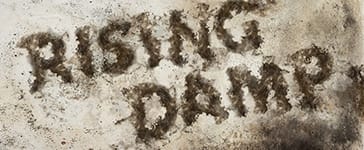
Damp. It’s one of those words you dread hearing when you are thinking of buying a house. Whilst it’s true that damp issues can be serious if left untreated, and the cost of repairs can be high and potentially disruptive, finding evidence of damp in a house doesn’t necessarily mean you shouldn’t proceed with the purchase.
Here is a guide to the key information you need to know if you are aware of, or suspect, damp issues to be present in a property you intend to purchase…
What is damp?
In general terms, damp is the presence of unwanted water or moisture in a building which, if untreated, can often lead to structural damage. There are 4 main types of dampness in properties: rising, penetrating, condensation and leaks, each of which has a different underlying cause and can vary in seriousness.
Damp types and treatments
- Rising Dampness – caused by a capillary action drawing moisture from the ground into the fabric of the building, as a result of no Damp Proof Course (DPC) or a failed DPC, or high ground levels.
How to cure? Rising damp is often fixed by the installation of a chemical Damp Proof Course by a specialist contractor. In the majority of cases, remedial damp work that resolves the issue can be completed for a few thousand pounds. However, you should be aware that this can be a disruptive and messy job and may require internal plaster being knocked off the walls, thereafter requiring re-plastering and redecorating at an additional cost to that of the work itself. You should also be aware that not all contractors undertaking such works are as reputable as others and damp issues can, in some cases, return.
- Penetrating Dampness – moisture entering a building by penetrating through the external fabric from outside (e.g. through the roof or walls), usually occurring during or following rainfall.
How to cure? Repairs to roofs, rainwater goods, walls, re-rendering, repointing masonry, re-sealing, etc.
- Condensation – forms when warm moist air settles on cold surfaces, often around windows. Cold spots can also form due to a lack of ventilation and heating, or poorly installed insulation.
How to cure? Very difficult especially in older houses however, ventilation and insulation can be improved and moisture levels reduced to ensure condensation is minimized.
- Leaks – from appliances, plumbing pipes, roofs, gutters, lead flashings can also cause dampness.
How to cure? Find the source and ensure regular preventative maintenance in carried out to ensure risk is minimised.
What else do I need to know?
The presence of damp can interfere with the buying process as many lenders will insist that damp issues are rectified before they lend on a property, thereby slowing own the process. In other cases, mortgage lenders can hold back a ‘retention’ on the amount they lend until the issue has been treated and inspected, meaning you will not only have to find the money for the repairs, but also the additional funds to complete the purchase.
If left untreated, damp can pose a number of risks including: structural timber decay, damage to plaster, corrosion, health issues for those with asthma and respiratory problems, unsightly staining and mould growth. It is also worth bearing in mind that the longer damp issues are left to go on, the greater the risk of lasting damage, which could ultimately reduce the value of a house.
What should you do?
The main thing you should do is to ensure you have a full Building Survey Report or RICS Homebuyers Report on the property to gain a complete picture of the extent of the damp and ascertain the approximate costs of repair work. Remember that as the buyer, it is your responsibility to investigate the condition of a property before buying it and the burden of any repair costs required once you have completed a purchase will fall with you. You may wish to consider paying for a specialist damp report on the property if there are particularly widespread damp problems.
For further advice on damp or to instruct Lea Hough to complete a RICS Homebuyers Survey or Building Survey Report, please contact us here.



